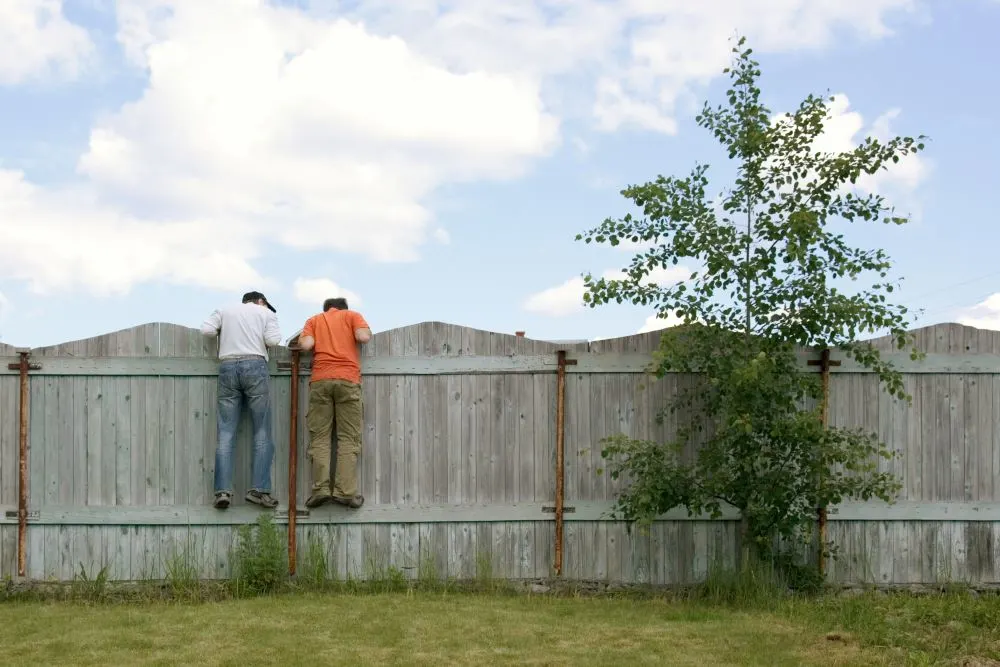It is a general rule of thumb that whenever a homeowner decides to build a fence, he/she should be ready to shoulder the entire cost of the project. However, fences don’t come cheap. HomeAdvisor estimates that it would cost between $1,700 and $4,210 to build a new fence.
You shouldn’t pay the total cost of erecting a new boundary fence if you don’t have to, i.e., if you have neighbors who will also benefit from it. In this article, I provide helpful tips on how to approach your neighbor to split the cost of building an adjoining fence. I also include a sample letter that you can use as a blueprint while drafting yours.

Ensure proper introductions are made. State intentions and mutual benefits of the new fence. Provide an estimated cost based on several quotes and ask the neighbor if they are open to contributing. Address any concerns they have. Obtain commitment to share expenses in writing and set up a payment plan.
Does Neighbor Have to Help Build the Fence?
State and City laws determine the fencing rules in a region. However, if the laws do not specify how fence building expenses should be tackled, then the issue is given over to the discretion of the affected homeowners.
It is general practice for landowners to share the cost of building and repairing a boundary fence. However, if the fence in question is a privacy fence, it is an entirely different ball game. While a boundary fence is built on the shared boundary line, a privacy fence is built within the boundaries of a property.

Thus, if your fence is a privacy fence, you are solely responsible for it and your neighbor’s contribution would only be out of goodwill rather than shared responsibility for the fence.
However, although certain state laws specify that all affected landowners are equally responsible for a boundary fence, there are special circumstances that come into play, especially when building rather than repairing the fence.
In most situations, the homeowner that initiates the project is responsible for a bulk of the fence expenses. This is especially true if the other party does not desire a fence or if a homeowner intends to make an aesthetic upgrade to a perfectly functional fence.
With that said, your neighbor isn’t duty-bound to shoulder the expenses of a fence you want to build if they are not financially able to cover the expenses of a new fence.
Step 1: Broach Topic with Neighbor
Your current relationship with your neighbor would determine how your initial approach will be. If you are already cordial, then you can proceed to inform them of your plans. However, if you’re not familiar with your neighbor, the first step is to introduce yourself to them, including the location of your property in the introduction.
In your meeting, you should tell them your reason for building or replacing the fence, even if it might seem obvious, like in the case of a weathered fence. While telling them your reason for wanting to erect the fence, you should subtly include one or two ways it would be beneficial to them as well.
After you’ve given them a run-down, inform them that you are open to contributions and would be grateful if they split the building expenses with you.
Since you are inviting them to contribute, you must have gotten the rough estimated cost of building the fence before approaching them. It’s best to get at least 3 quotations from contractors.
You could give them time to think about it and exchange contact details so that if they agree to help with the project, you can discuss further details together.
If it is impossible to meet them in person, you can send them a note in the postbox introducing yourself and then stating your intentions.
Step 2: Get All the Information
You would have to familiarize yourself with neighborhood fencing laws. If you reside in an HOA community, then the HOA probably has recommended fence design and heights for houses in the neighborhood.
In order not to appear unserious, you would have to gather all the important information required for the project before writing to your neighbor. So, what do you need?
- Although your neighbor might request adjustments if they agree to split the fencing expenses, you should still provide them with information about the proposed materials, style, and dimension of the fence.
- You need to have detailed quotes from contractors, identifying what contractor you intend to go with and the reason they’re your top choice.
- Finally, you need to suggest a date(s) for the commencement of the project as well as its timeframe.

By providing a detailed description of the project, you show conscientiousness and regard for them. This could even encourage them to contribute to the project.
You should also let them know that you’re open to addressing any concerns they might have.
To prevent disputes or miscommunication, send the information in a written or traceable electronic format.
Sample Letter
From:
Your name
Address
Date
To:
Neighbors’ name
Address
Dear (neighbor’s name),
Replacement of Shared Fence
I’m writing to inform you of my intention to replace our shared fence. As you know, the current fence is too short, hence it doesn’t provide an effective barricade for both our pets (reason for building/replacing the fence).
I’ve contacted a couple of fencing companies and have attached quotes from four of the best offers I got to this letter. However, I would like to go with Hill Side Fences, as their price and service description is better than the others.
The fence would be in the same location as the current fence. There would also be no change in the width. Instead, I intend to erect a fence of 7’ to replace the current fence that’s merely 4’ high.
The fence would also be built with the same material as the current fence (fence material/style).
The project would take only one day and I would like to commence on _______. However, if this date isn’t convenient for you, we can agree on a different time.
I’m open to your contributions, financial and otherwise, and would immensely appreciate it if you share in the fence building expenses since the new fence would benefit you as well.
You can contact me on ______ so that we can discuss how the fencing cost will be split. You can also reach out to me if you have any queries or concerns.
I look forward to your response.
Best Regards,
Signature
Your Name.
You can download printable a pdf copy of the letter.
Step 3: Address Any Concerns
Before approaching your neighbor, you should have figured out the basic details of the project so that you can give convincing answers to any question they might have.
At this stage, you must have sent them a letter that provides details on the fence material, dimensions, cost, and proposed construction date.
While some neighbors might go with whatever you decide, even if they’re sharing in the expenses, others might require that you make some adjustments before they agree to split the fencing cost.
If your neighbor isn’t satisfied with the date you have chosen for the project then you both can decide on a date that’s convenient for both parties.
However, if they want you to make changes to things like the material or the dimension of the fence, especially if the changes will cause you additional cost or inconvenience, you should insist that they provide a portion of the fencing cost.

One of the reasons homeowners do not contribute to shared projects is the timing. Sometimes, it’s not because they do not want to contribute to the project, but rather because they have more pressing financial responsibilities at that moment.
Thus, if the fence doesn’t have to be built/replaced urgently, you can ask them when they would be able to contribute, so that you can postpone the project until then. If you bring up the postponement of the project and they still give you excuses, then they’re probably not interested in contributing to the project at all.
Before finalizing with the contractor, you need to ensure that your neighbor is on the same page as you. This way, you avoid building a fence that they find displeasing and ultimately prevent any dispute this might cause.
Step 4: Agree How Costs Will Be Split and Paid
If they agree to pay a portion of the fencing cost, you both would have to decide on the payment model before you proceed with the project.
- Are you both covering a particular percentage of the cost? If you are, what percentage is each party expected to pay? They could agree to split the expenses 50%-50% or you could pay a larger percentage so that they cover 40% or 30% of the cost.
- Are they committing a specific amount to the cause? If they agree to bring what they have, how much are they contributing?
- Are they covering specific costs? For instance, they could agree to pay for labor or some of the fencing materials.
- When can they make the finances available?
- Who are they sending the funds to? Are they sending it directly to the contractor or are they sending the money to you? You’d have to provide a convenient mode of payment.
A lot of conflict between homeowners arises when one party reneges on an agreement such as this. Thus, it’s best to finalize every money-related issue before the project starts. If you can, avoid agreeing to a reimbursement.
If you would like some more tips on how to approach your neighbor, I have written helpful guides for replacing an old fence or building a new fence.
Sources
https://www.findlaw.com/realestate/neighbors/fencing-laws-and-your-neighbors-faqs.html#
https://www.calibrerealestate.com.au/dividing-fences/
https://sierrafencetx.com/how-to-approach-a-neighbor-about-replacing-a-shared-fence/
